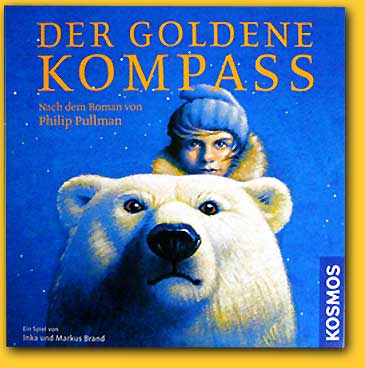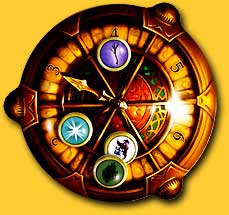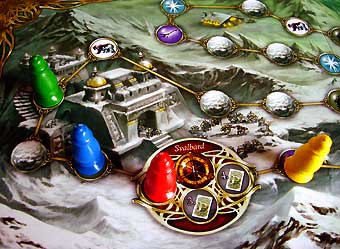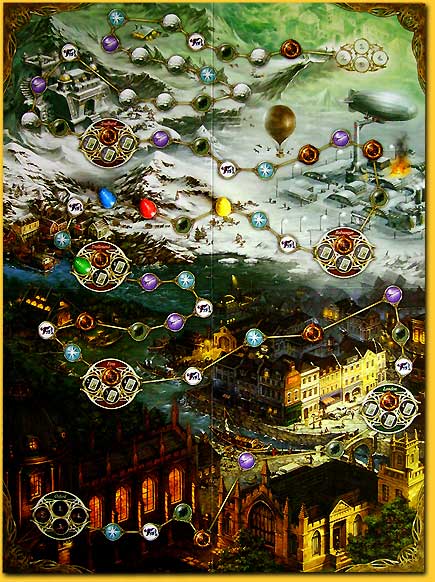Der goldene Kompass
Authors: Inka & Markus Brand
Publisher: Kosmos
Year: 2007
review by

| x |
|
|
|
|
|
|
|
|
|
|
|
|
|
|
|
|
|
|
|
|
|
|
|
|
|
|
|
|
|
|
|
|
|
|
|
|
|
|
|
|
|
|
|
|
|
 |
Wow! That sounds exciting! The rules start with a very concise, comprehensive and summarised excerpt of what undoubtedly is a very thrilling children’s book: 'The golden Compass' by Philip Pullman. Who did not read such books in his childhood, comfy sitting with folded legs under your bottom in the arm chair, captivated by the story that unfolded before your reading eyes. Elsewhere at home your mother was busy with her daily work, maybe doing the laundry, or busy making food, and dad was at his office or with a customer - yes, the world was conveniently arranged at that time... And you, you were there, but also not: completely fascinated of the world inside your book; you sucked the words from the pages, one after the other. What a stunning book! Would it not be nice to have a boardgame from it and revive the adventures of the book?
In ‘Der goldene Kompass’ two to four players set out, picking up knowledge and experience on the way. The player who manages to show up at the end with three friends and enough experience has won the game.
|
Each player is dealt four movement cards and a special card at game start, and has a compass, a cardboard disc, to mark the level of his experience with small round coloured markers in the four different fields; at game start he has zero experience. The move cards show a value between one and three and by playing one a player moves an amount of fields. Only: fields occupied by other players do not count, so it could well be that a player who is behind ends up in front, only by playing a ‘1’ card, assuming all other players in front of him have no empty spaces in between them. That makes good progress! But this is one side of our thrilling story; the other side is that we need to acquire the necessary experience, and this demands less speed.
Also at game start each player has been dealt a socalled encounter card; he must have fulfilled three of these during the course of the game to succesfully sign off at the end station. The encounter cards require a specific position of the four markers on the compass; this position can be increased when after movement a player lands on the corresponding symbol. |
|
 |
|
|
| x |
|
|
|
|
|
|
|
|
|
|
|
|
|
|
|
|
|
|
|
|
|
|
|
|
|
|
|
|
|
|
|
|
|
|
|
|
|
|
|
|
|
|
|
|
|
More or less evenly scattered over the track are the larger locations. Here the first player gets an increase on his compass for any one marker; any other player landing here may take a special card; these cards generally help in movement or gathering experience.
In a turn, a player may play several cards, at the same time, and as many times as he wishes. This way he can make more moves in one turn, and increase his experience in several or the same fields on the compass. |
| x |
|
|
|
|
|
|
|
|
|
|
|
|
|
|
|
|
|
|
|
|
|
|
|
|
|
|
|
|
|
|
|
|
|
|
|
|
|
|
|
|
|
|
|
|
|
| After each player has made his move, first a new starting player is determined; this is the player who currently is at the last position. Thjis player fills his hand with four movement or special cards, in any combination, taking care not to exceed the hand limit of eight cards. The second last player may take three cards, the player second in line takes two, and the player in front may take only one card. At the start of the game the players were dealt cards in their own colour, but during the game it becomes important to also take cards from other colours; after a player has reached the location called ‘Fens’ he only may play certain coloured cards, dependent on his current position. When he is in front, he may only play cards in his own player colour. If there are players in front of him, he may only play cards of that colour in order to get his pawn moving. |
|
 |
| x |
|
|
|
|
|
|
|
|
|
|
|
|
|
|
|
|
|
|
|
|
|
|
|
|
|
|
|
|
|
|
|
|
|
|
|
|
|
|
|
|
|
|
|
|
|
 |
|
When a player has the necessary experience on his compass, he may make the encounter on his card, distracting some of the experience on the compass that is shown on the encounter card. In return he may take a friends card form a stack of varying friends, that he keeps for the rest of the game and may help him on specific fields, but again mostly in movement or experience.
From the location ‘Svalbord’ on, the arctic fields begin that hinder a player in his movement. Ionek Byrnison, one of the possible to be acquired friends, may help to overcome this inconvenience and turn the obstacles into ice fun! Once a player has reached the end, he must have fulfilled his three encounters, and have all his markers on the compass on the ‘3’ position in order to claim victory. |
| x |
|
|
|
|
|
|
|
|
|
|
|
|
|
|
|
|
|
|
|
|
|
|
|
|
|
|
|
|
|
|
|
|
|
|
|
|
|
|
|
|
|
|
|
|
|
| x |
|
|
|
|
|
|
|
|
|
|
|
|
|
|
|
|
|
|
|
|
|
|
|
|
|
|
|
|
|
|
|
|
|
|
|
|
|
|
|
|
|
|
|
|
|
 |
|
|
|
|
|
|
|
|
|
|
|
|
|
|
|
|
|
|
|
|
|
|
|
|
|
|
|
|
|
|
|
|
|
|
|
|
|
|
|
|
|
Pan- or Lyra cards, with or without John Faa or Lee Scoresby, it just does not get to the suggested atmosphere. This does not count for the again impressive artwork by Michael Menzel (Michael: please deposit donations at 7777777, Fantasia Bank), fascinating every adult, and even gives the occasional player the shivers, like the card ‘Forscher von Bolvanger’ (‘Researcher of Bolvanger’). But despite this decoration it is a poor and rather ordinary walking game that lacks tension.
Of course, it is not easy to transform a book into a boardgame, but Kosmos already delivered a fine example of this category with ‘Pillars of the Earth’. Not every attempt can be succesful, however, but despite the difficult task the authors have made the best of it. Nice about the game are the mechanics of movement. But apart from this there is hardly anything nice to experience. The assignments don’t really get any harder; there only is an increasement of the experience to gain. Play goes linear from beginning to end, only forwards, no sideways - it is a tight corsage we are in. After a while boredom strikes; one move suspiciously resembles another, and the tension around the table gradually gets less and less. The death blow for the game comes when the thought looms up: ‘If only the game would end’, so in effect when you do not care anymore if you win or lose.
Nevertheless, it is a good thing that Kosmos has devoted itself with his expertise on this conversion, together with the dedication and effort of professionals in the field. We would not like to know what Mattel would have made of this! It is a known marketing fact that several products can support and even strengthen each other, albeit it in a somewhat strange way: ‘Der goldene Kompass’, the board game, makes one curious about the movie!
© 2007 Richard van Vugt
|
x |
Der goldene Kompass, Inka & Markus Brand, Kosmos, 2007 - 2 to 4 players, 10 years and up, 60 minutes
|
  |
|
|
|
|
|
|
|
|
|
|
|
|
|
|
|
|
|
|
|
|
|
|
|
|
|
|
|
|
|
|
|
|
|
|
|
|
|
|
|
|
|
  |
|
|
|
|
|
|
|
|
|
|
|
|
|
|
|
|
|
|
|
|
|
|
|
|
|
|
|
|
|
|
|
|
|
|
|
|
|
|
|
|
|
  |
|
|
|
|
|
|
|
|
|
|
|
|
|
|
|
|
|
|
|
|
|
|
|
|
|
|
|
|
|
|
|
|
|
|
|
|
|
|
|
|
|
  |
|
|
|
|
|
|
|
|
|
|
|
|
|
|
|
|
|
|
|
|
|
|
|
|
|
|
|
|
|
|
|
|
|
|
|
|
|
|
|
|
|
|
|
|
|
| x |
|
|
|
|
|
|
|
|
|
|
|
|
|
|
|
|
|
|
|
|
|
|
|
|
|
|
|
|
|
|
|
|
|
|
|
|
|
|
|
|
|
|
|
|
|
| x |
|
|
|
|
|
|
|
|
|
|
|
|
|
|
|
|
|
|
|
|
|
|
|
|
|
|
|
|
|
|
|
|
|
|
|
|
|
|
|
|
|
|
|
|
|
 |
|
|
|
|
|
|
|
|
|
|
|
|
|
|
|
|
|
|
|
|
|
|
|
|
|
|
|
|
|
|
|
|
|
|
|
|
|
|
|
|
|
 |
|
|
|
|
|
|
|
|
|
|
|
|
|
|
|
|
|
|
|
|
|
|
|
|
|
|
|
|
|
|
|
|
|
|
|
|
|
|
|
|
|
| x |
|
|
|
|
|
|
|
|
|
|
|
|
|
|
|
|
|
|
|
|
|
|
|
|
|
|
|
|
|
|
|
|
|
|
|
|
|
|
|
|
|
|
|
|
|
 |
|
|
|
|
|
|
|
|
|
|
|
|
|
|
|
|
|
|
|
|
|
|
|
|
|
|
|
|
|
|
|
|
|
 |
|
|
|
|
|
|
|
|
|
|
|
|
|
|
|
|
|
|
|
|
|
|
|
|
|
|
|
|
|
|
|
|
|
|
|